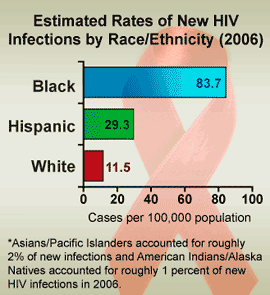December 1 is World AIDS Day; a day meant to draw attention to the global AIDS pandemic and bring pressure to bear upon public health officials to commit the necessary resources to combat the crisis. In the United States HIV/AIDS is exacting a particularly heavy toll upon Black Americans as the disease has reached epidemic status in the Black community.
 Since the beginning of the AIDS epidemic Blacks have accounted for 42 percent of all cases diagnosed in the 50 states and the District of Columbia. According to data from the U.S. Centers for Disease Control and Prevention (CDC), Blacks now account for just under half of all people who get HIV and AIDS despite being only 13 percent of the country’s population. Not only do Blacks with AIDS have a shorter rate of survival, HIV/AIDS is now the leading cause of death among Black Americans.
Since the beginning of the AIDS epidemic Blacks have accounted for 42 percent of all cases diagnosed in the 50 states and the District of Columbia. According to data from the U.S. Centers for Disease Control and Prevention (CDC), Blacks now account for just under half of all people who get HIV and AIDS despite being only 13 percent of the country’s population. Not only do Blacks with AIDS have a shorter rate of survival, HIV/AIDS is now the leading cause of death among Black Americans.
Among men, 41 percent living with HIV/AIDS were Black. The most common methods of contracting the disease for Black men was unprotected sex with another male who has HIV, sharing needles or syringes with someone who has HIV, and having unprotected sex with a woman who has HIV. The epidemic is ravaging Black women, who now account for 64 percent of all women living with HIV/AIDS. For Black women heterosexual contact is the primary transmission category, with 74 percent contracting the disease in this manner. It is a striking statistic that raises serious concerns over heterosexual relationships between Black men and Black women, and the degree to which gender conflict over issues of truthfulness concerning sexual identity will cause irreparable harm to birth rates in the Black community. If Black women become distrustful of Black men due to the high rate of infection driven by heterosexual relations, the likelihood of their seeking options outside their race for dating becomes much higher.
The CDC points out that the picture is equally ominous for Black children and young adults. In 2005 of the 166 children under the age of 13 diagnosed with HIV/AIDS in 33 states, 63 percent were Black. For the 18,849 young adults under the age of 25 who were diagnosed with HIV/AIDS in the 33 states with HIV reporting, the CDC data reveals 61 percent were Black. The simple fact is that HIV/AIDS is devastating the Black community and affecting children, young adults and middle age Blacks, particularly women.
For Black Americans there are a number of clear risk factors and barriers to prevention of HIV/AIDS. For many years the perception of HIV/AIDS as a “gay disease” prompted many Blacks to turn a blind eye toward its growing impact on the heterosexual community. Complicating matters was the initial reaction of the Black church, and many Black ministers, to the epidemic; many casting HIV/AIDS in Biblical terms and attributing it to sinful behavior in a way that left no room for a purely clinical discussion of the disease and its consequences. The latter may also be responsible for the reluctance of many Black men to speak openly about their sexuality out of fear of being stigmatized in a community that still struggles with homophobia.
Risk factors driving the rate of HIV/AIDS in the Black community include high-risk sexual contact, women having sex with men who have unprotected sex with other males; substance abuse, including sharing needles and engaging in unprotected sex while under the influence of drugs or alcohol; lack of awareness of one’s HIV status, homophobia and the concealment of homosexual behavior and sexually transmitted diseases (STD’s). The latter should be noted because CDC data suggests the high rates of HIV infection for Black men who have sex with other men may be partly attributable to a high prevalence of STD’s that facilitate HIV transmission. In 2005 Blacks were 18 times as likely as whites to have gonorrhea and about 5 times as likely to have syphilis.
No matter what the risk factor or actual cause of transmission, the fact is that HIV/AIDS is running rampant in the Black community and unless it is taken seriously as the epidemic it is, untold thousands of Black Americans are at risk of an early death. The recognition of the gravity of the crisis is long overdue and public education must extend to early adolescence if the nation is truly committed to halting the spread of HIV/AID’s in the Black community. It will not only require government intervention but necessitates Black institutions such as the church and historically Black colleges and universities to play a more dominant role in encouraging open dialogue, advocating safe sex practices and behavior, testing and treatment for those with HIV. While there is no single remedy, collective action will help reverse this deadly trend in the Black community.




















